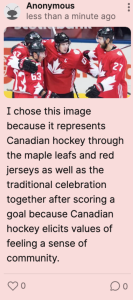4
These are difficult stories. We bear witness in this chapter to the role of sport in furthering the settler colonial projects throughout Turtle Island. Here are some supports to access in the community and from a distance:
First Peoples House of Learning Cultural Support & Counselling
Niijkiwendidaa Anishnaabekwag Services Circle (Counselling & Healing Services for Indigenous Women & their Families) – 1-800-663-2696
Nogojiwanong Friendship Centre (705) 775-0387
Peterborough Community Counselling Resource Centre: (705) 742-4258
Hope for Wellness – Indigenous help line (online chat also available) – 1-855-242-3310
LGBT Youthline: askus@youthline.ca or text (647)694-4275
National Indian Residential School Crisis Line – 1-866-925-4419
Talk4Healing (a culturally-grounded helpline for Indigenous women):1-855-5544-HEAL
Section One: History
A) The Residential School System
Exercise 1: Notebook Prompt
We are asked to honour these stories with open hearts and open minds.
Which part of the chapter stood out to you? What were your feelings as you read it? (50 words)
| The part that stood out to me the most was the irony in white people viewing first nation children as talented and loved listening to them in concerts. I felt angry as I read they would comment things like “I appreciated them very much” and that the audience would cry listening to them because they were so good because they deserved so much better. |
B) Keywords
Exercise 2: Notebook Prompt
Briefly define (point form is fine) one of the keywords in the padlet (may be one that you added yourself).
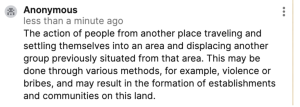
| The action of people from another place traveling and settling themselves into an area and displacing another group previously situated from that area. This may be done through various methods, for example, violence or bribes, and may result in the formation of establishments and communities on this land. |
C) Settler Colonialism
Exercise 3: Complete the Activities
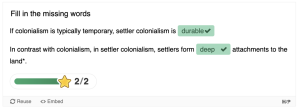
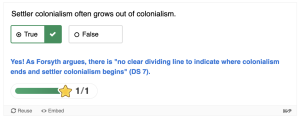
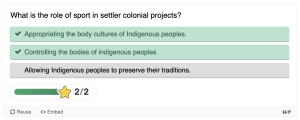
Exercise 4: Notebook Prompt
Although we have discussed in this module how the colonial project sought to suppress Indigenous cultures, it is important to note that it also appropriates and adapts Indigenous cultures and “body movement practices” (75) as part of a larger endeavour to “make settlers Indigenous” (75).
What does this look like? (write 2 or 3 sentences)
| This looks like settlers participating in activities that were originally indigenous like snowshoeing and playing lacrosse and taking away their meaning. This takes away the spiritual ties indigenous had to them and is included in western culture making their purpose for “fun” or to “give people a sense of community”. |
D) The Colonial Archive
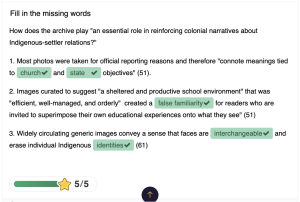
Exercise 5: Complete the Activities
Section Two: Reconciliation
A) Reconciliation?
Exercise 6: Activity and Notebook Prompt
Visit the story called “The Skate” for an in-depth exploration of sport in the residential school system. At the bottom of the page you will see four questions to which you may respond by tweet, facebook message, or email:
How much freedom did you have to play as a child?
What values do we learn from different sports and games?
When residential staff took photos, what impression did they try to create?
Answer one of these questions (drawing on what you have learned in section one of this module or prior reading) and record it in your Notebook.
| I had a lot of freedom to play as a child making me feel even more bad for the kids who had to go through the trauma of the residential schools. To be told how to act, what culture is right, to be stripped of their families and not allowed to have their own values or beliefs in sports is not right. I loved playing sports and my family was very supportive of what I wanted to do and gave me lots of freedom as a kid. |
B) Redefining Sport
B) Sport as Medicine
Exercise 7: Notebook Prompt
Make note of the many ways sport is considered medicine by the people interviewed in this video.
| People in the video consider sports medicine because it was an escape from the trauma they faced as people who are indigenous. The memories of the trauma stick with you forever but sports were happy and promoted wellbeing. They were stripped of other ways to express their culture like language but they always had sport. |
C) Sport For development
Exercise 7: Notebook Prompt
What does Waneek Horn-Miller mean when she says that the government is “trying but still approaching Indigenous sport development in a very colonial way”?
| She means the government is giving them the bare minimum by working through their own beliefs to set up sports with their views on how they should be. The government should learn to collaborate with people who are indigenous more so they can align their beliefs and values of the sports together, therefore empowering indigenous communities. |
Exercise 8: Padlet Prompt
Add an image or brief comment reflecting some of “binding cultural symbols that constitute Canadian hockey discourse in Canada.” Record your responses in your Notebook as well.
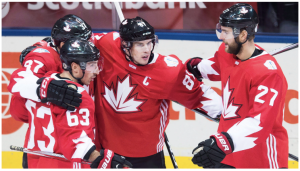
I chose this image because it represents Canadian hockey through the maple leafs and red jerseys as well as the traditional celebration together after scoring a goal because Canadian hockey elicits values of feeling a sense of community.
|
Section Three: Decolonization
Please see the major assignment for this half of the term in the final section of this chapter.

